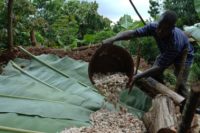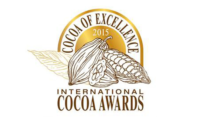
Photo courtesy of Cargill, Inc.
By Crystal Lindell, Associate Editor
It’s a bleak outlook for the cocoa commodities this year, at least according to one major food company.
Officials form Cargill, which has been hosting cocoa presentations across the U.S. this year, say there are potential problems on the horizon for everything from farming to supply and demand.
In a testament to how tumultuous things might be for the industry, Martijn Bron, the company’s trading and sourcing manager, spent a lot of time discussing the current political conflicts in the Ivory Coast in Africa - a topic that wasn’t nearly so stressful as recently as a few months ago.
Bron says the political turmoil - the result of an election that has yet to be worked out - matters because the country is the No. 2 cocoa grinder in the world, and the No. 1 producer of beans.
“It doesn’t only have an effect on beans, but on product as well,” he explains.
As of late January, the international community has been imposing sanctions on the cocoa industry there in an effort to force Incumbent President Laurent Gbagdoto to cede power to President-elect Alassane Outtara.
“Everyone is trying to figure out what the impact is,” Bron says. “This is Africa, so it’s really lots of speculation.”
Another issue on Cargill’s radar is plant life spans. Bron explains that cocoa trees typically are at their peak between about six years old and about 20 years old. Cargill estimates that the average trees in the Ivory Coast are about 15 or 16 years old right now.
However, even if farmers wanted to replenish their fields with new trees, free land is extremely limited.

Photo courtesy of Cargill, Inc.
It’s not all bad news though. Bron says the crop in Ghana is much better that that in the Ivory Coast, at least partly because the government there helps farmers. Meanwhile, in Indonesia, farmers are starting to use grafting techniques to improve yields.
Also, Cargill is working to educate cocoa farmers about better techniques, and is working to expand UTZ Certifications, which guarantee good agricultural practices, and that cocoa farming meets certain social and environmental criteria.
In addition, many cocoa farmers saw ideal weather this year and as a result have large crops.
Bron explains that the hope is that they will be able to use their extra revenue to invest in their farms. However, he adds that farmers haven’t quite done in recent years, likely because the income increase hasn’t been enough of an incentive yet.
Another problem the industry is facing is an excess of cocoa butter. Piet van Amelrooij, director of cocoa powder sales, explains that as more countries have a growing middle class, the demand for cocoa powders increase for things like flavoring. That results, however, in an excess of cocoa butter, which impacts prices.
“Powder demands needs to be brought in balance with butter,” van Amelrooij, says.
Bron says it’s a problem that’s not likely to be under control anytime soon, though.
“The world is still griding for powder and we don’t see that changing on short notice,” he says.
The hope is that as companies like Cargill spread awareness about all these issues things will start to look a little brighter for an industry so many people depend on.



